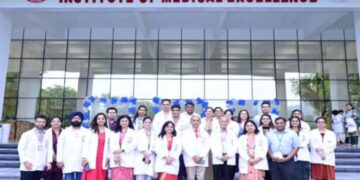I-STEM (Indian Science, Technology, and Engineering facilities Map), an initiative from the Office of Principal Scientific Advisor, Government of India, organized ‘Samavesha’ National event at the Indian Institute of Science (IISc), Bangalore, to connect Researchers, Industry, and Start-ups with Lab facilities on Jan 16.
It is pertinent to mention that I-STEM provides a platform to provide Research infrastructure and Labs that can be availed by users across India.The project targets connecting researchers with scientific institutes through an online portal. The Researcher or the industry looking to avail advanced scientific equipment can connect with the institution that has the equipment they are looking for and rent it to conduct their experiments, through the I-STEM Portal.This saves the researchers, industry, and start-ups the prohibitive capital expenditure of purchasing advanced equipment. At the National level, this prevents duplication of resources in the research institutions. The I-STEM network already has 27,730 ‘Users’ such as researchers, industry, & start-ups, alongside 2,350 Research and Academic Institutes across India that lend their scientific infrastructure such as labs to the ‘Users’.
Delivering the inaugural address as chief guest for the event, Dr. Parvinder Maini, Scientific Secretary in the Office of Principal Scientific Adviser to the Government of India, said, “Today, everyone is stressing inclusive growth for a sustainable society. A more equitable distribution of resources will contribute to social stability. The resources we share will also cause a lot of social stability among the entire community. The Researchers who have public-funded projects are custodians of the equipment and the Government is the owner. To ensure that all researchers in the country get an equal opportunity to work and have access to the equipment and facilities, the idea of I-STEM was originated”
She added, “We also have to see that awareness of I-STEM reaches all strata of researchers. All aspects of making research and infrastructure accessible should be considered irrespective of gender or anything. I urge I-STEM to see that researchers from the economically weaker sections get an edge. We must try and reserve 10 to 15% of funds for the economically weaker sections and give them free of cost. Regardless of gender, ethnicity or other characteristics, equal opportunities ensure that most qualified and capable individuals contribute to the economy of the country.”
The vision of I-STEM is to create a future where one million New-Age researchers, brimming with ideas, are seamlessly connected to a network of 10,000 cutting-edge labs across India. By 2024, I-STEM aims not only to connect individuals to equipment but also to ignite a collaborative ecosystem where start-ups, industries, and academia co-create the next wave of innovation.
Speaking on the occasion, Prof. Navakanta Bhat, Principal Investigator of I-STEM, and Dean (Department of Interdisciplinary Science), IISc, Bengaluru, said, “For any idea to be successful, we need both top-down and bottom-up approach. The I-STEM idea was started and conceived by the Office of Principal Scientific Adviser to the Government of India. We have received phenomenal support from their office. Only when we have a large number of institutions and researchers join the fold of I-STEM and subscribe to the idea that we need shared resources and create this culture of collaboration, we will be able to do research at the highest level, innovate and translate. That is the idea of I-STEM.”
Highlighting the role of I-STEM in boosting the Science and Technology sector in India, its Chief Operating Officer and National Coordinator Dr. Harilal Bhaskar said, “Samavesha is not just an event but a movement propelling the Nation into an era in which collaboration is the currency of progress. Let us unlock its power, breaking barriers, fostering connections, and creating an environment in which ideas flourish. As we embark on this transformative journey, I am sure Samavesha will become a beacon, lighting the path to a future where innovation knows no bounds. With Samavesha, any publicly-funded lab will become available at the fingertips of researchers, creating awareness and access like never before.”
The key impact envisaged from Samavesha include
- Increased Indigenous Product Innovation: Collaborative synergy is expected to significantly boost innovation.
- Knowledge Exchange Ecosystem: SAMAVESHA seeks to create a thriving knowledge exchange environment, driving research and development.
- National Advancements: Breaking down access barriers, the event aspires to make India a hub for groundbreaking discoveries and homegrown advancements.













